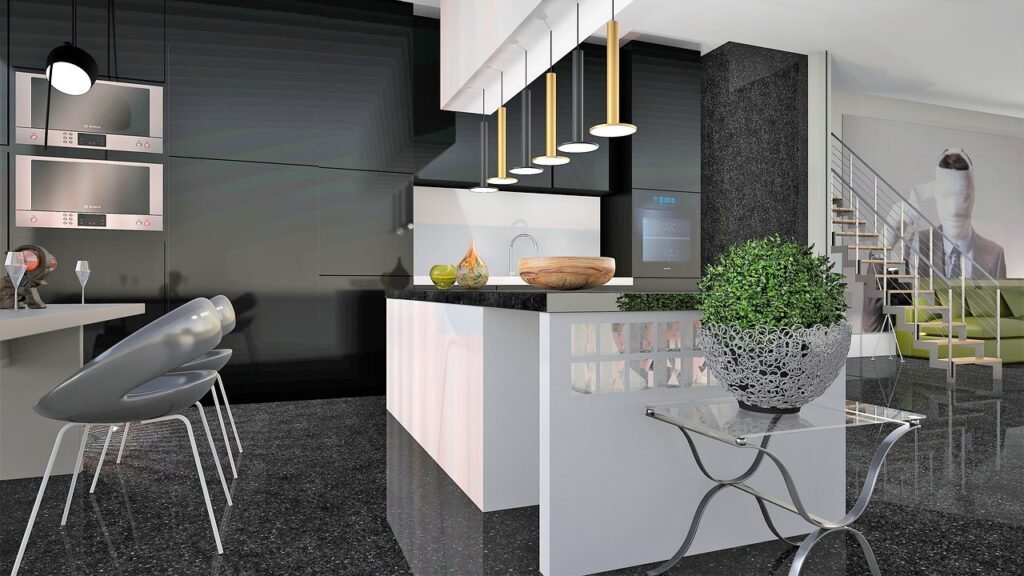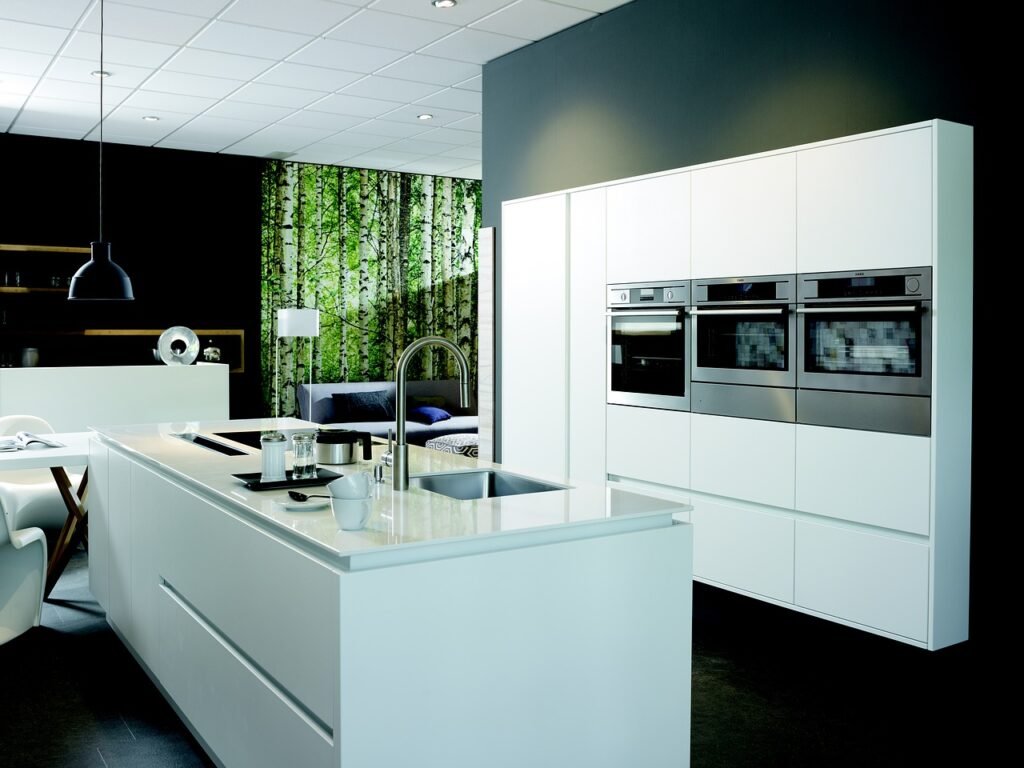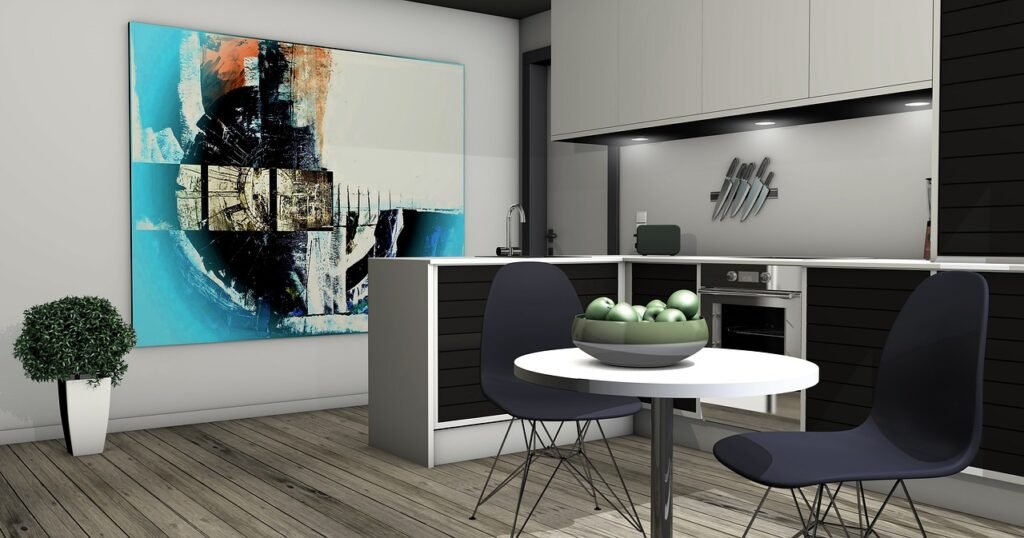In “The Ultimate Guide to Essential Kitchen Lighting Design Tips,” you will discover a comprehensive collection of expert suggestions to illuminate your kitchen to perfection. From creating a warm and inviting atmosphere to enhancing functionality, these essential tips will guide you in choosing the right type of lighting, positioning fixtures strategically, and selecting suitable bulbs. Whether you are a seasoned decorator or a novice in the realm of interior design, this guide will equip you with the knowledge and inspiration necessary to transform your kitchen into a well-lit haven. So, let’s shed some light on your culinary space and explore the art of kitchen lighting together.

This image is property of pixabay.com.
Types of Kitchen Lighting
1. General Lighting
General lighting in the kitchen is the primary source of illumination that provides overall brightness to the space. It usually consists of ceiling-mounted fixtures such as recessed lights, flush mounts, or track lighting. General lighting is essential for creating a well-lit environment and ensuring that you can move around the kitchen safely and comfortably.
2. Task Lighting
Task lighting focuses on specific areas where detailed activities take place, such as food preparation or cooking. It is designed to provide targeted illumination, reducing shadows and enhancing visibility. Under cabinet lighting, pendant lights over an island, or adjustable lighting fixtures are popular task lighting options in the kitchen.
3. Accent Lighting
Accent lighting adds an extra layer of lighting to highlight specific features or objects in the kitchen. It creates visual interest and adds a touch of style to your space. Accent lighting can be used to showcase architectural elements, artwork, or decorative items. This type of lighting is often achieved through the use of recessed spotlights, track lighting, or LED strip lights.
Considerations for Kitchen Lighting Design
1. Layout and Functionality
When designing your kitchen lighting, consider the layout and functionality of the space. Take into account the placement of cabinets, countertops, and appliances to determine the areas that require specific lighting. This will help you identify the ideal locations for task lighting fixtures and ensure that general lighting covers the entire kitchen effectively.
2. Natural Lighting
Maximizing natural lighting in your kitchen not only saves energy but also enhances the overall ambiance. Consider the placement and size of windows to allow for ample daylight. Choosing window treatments that let in natural light while providing privacy is essential. Additionally, using reflective surfaces, such as glossy tiles or stainless steel appliances, can help bounce natural light around the space.
3. Electrical Considerations
Before installing any lighting fixtures, it is crucial to consider the electrical aspects of your kitchen. Plan the positioning of electrical outlets to conveniently power your lights and any appliances you may use. Ensure that adequate wiring is in place to handle the electrical load required for your lighting design. Furthermore, determine the placement of switches for easy access and consider incorporating lighting control systems to manage different lighting zones.
4. Color Temperature
Color temperature refers to the perceived warmth or coolness of light. Choosing the right color temperature for your kitchen lighting can greatly impact the atmosphere and functionality of the space. Warm lighting (2700K-3000K) creates a cozy and inviting ambiance, while cool lighting (3500K-5000K) promotes concentration and clarity. Mixing different color temperatures in your kitchen can add depth and balance to the overall lighting design.
5. Energy Efficiency
Kitchen lighting should not only be aesthetically pleasing but also energy-efficient. Opting for energy-efficient lighting options can help reduce electricity consumption and utility costs. LED lighting is an excellent choice for its long lifespan and low energy consumption. Consider using energy-efficient light bulbs and incorporate sensors or timers that automatically turn off lights when not in use.
6. Dimming Options
Dimming your kitchen lights allows you to adjust the brightness according to different tasks and moods. Installing dimmer switches gives you the flexibility to create the desired ambiance, whether you need bright task lighting or a soft glow for entertaining. Ensure that the dimmer switches you choose are compatible with the type of lighting you have, especially if you are using LED bulbs.
General Lighting Tips
1. Choosing the Right Fixtures
When selecting general lighting fixtures for your kitchen, consider the style, size, and shape that will best suit your space. Recessed lights are a popular choice as they blend seamlessly into the ceiling, providing a clean and unobtrusive look. Flush mounts, on the other hand, offer a more stylish option and come in various designs to match your kitchen decor. Track lighting allows for flexibility in directing light to different areas.
2. Placement and Spacing
Proper placement and spacing of general lighting fixtures are crucial for achieving uniform illumination. In a kitchen, it is generally recommended to install recessed lights or flush mounts every four to six feet to avoid any dark spots. This creates consistent light distribution in the room and ensures that no shadows interfere with your activities.
3. Selecting the Appropriate Bulbs
Choose bulbs that provide the desired brightness and color temperature for your general lighting. LED bulbs are energy-efficient and offer a wide range of color options. Consider the lumens (brightness) and the color temperature of the bulbs to achieve the desired illumination and ambiance.
4. Installing Dimmer Switches
Adding dimmer switches to your general lighting allows you to adjust the brightness level to your preference. This can help create a cozy atmosphere for intimate gatherings or provide brighter lighting when conducting detailed tasks. Ensure that the dimmer switches are compatible with the type of bulbs you are using, especially if you have opted for LED lighting.
5. Creating a Layered Lighting Design
A layered lighting design combines different types of lighting to create a multifunctional and visually appealing kitchen. By incorporating general, task, and accent lighting, you can achieve a well-balanced and versatile lighting scheme. This allows you to tailor the lighting to different activities, enhancing functionality and aesthetics simultaneously.
Task Lighting Tips
1. Identifying Task Lighting Areas
Identify the specific areas in your kitchen where task lighting is needed the most. Common task lighting areas include the countertop workspace, stovetop, sink, and any other location where you frequently perform detailed tasks. By highlighting these areas with appropriate task lighting fixtures, you can improve visibility and enhance safety.
2. Under Cabinet Lighting
Under cabinet lighting is a practical solution for illuminating the countertop workspace. It eliminates shadows caused by overhead lighting and provides direct light for food preparation, cutting, and cooking. LED strip lights or puck lights are popular choices for under cabinet lighting as they are easy to install and offer excellent task lighting.
3. Pendant Lighting for Islands
When it comes to islands or breakfast bars, pendant lighting can be both functional and decorative. Pendant lights placed above the island provide task lighting for activities such as dining, food preparation, or reading recipes. Consider the height and size of your pendant lights to ensure they are proportional to the island and create a visually pleasing effect.
4. Adjustable Lighting for Workspaces
Incorporating adjustable lighting fixtures in workspaces allows you to direct the light precisely where it is needed. For example, adjustable recessed lights or track lighting with movable heads can be angled to highlight specific areas on the countertop or stovetop. This flexibility ensures that you have optimal lighting for various tasks without creating unwanted glare or shadows.
5. Lighting for Specific Tasks
Consider specific task lighting fixtures tailored to the tasks you frequently perform in the kitchen. For instance, installing a pot rack with integrated lighting above the stovetop provides focused illumination for cooking. Similarly, installing a lighted range hood can improve visibility while cooking and enhance the overall kitchen design.

This image is property of pixabay.com.
Accent Lighting Tips
1. Highlighting Architectural Features
Use accent lighting to draw attention to the architectural features in your kitchen. Whether it’s a beautiful backsplash, a textured wall, or exposed beams, accent lighting can create a striking visual impact. Wall-mounted sconces, recessed spotlights, or track lights can be used to highlight these features, adding depth and character to your space.
2. Display Lighting for Showcasing Items
If you have any prized possessions, artwork, or decorative items in your kitchen, accent lighting can help showcase them. Using track lighting or adjustable spotlights, you can creatively illuminate these objects and make them stand out. This adds a personalized touch to your kitchen and creates focal points for the eye to be drawn to.
3. Adding Drama and Visual Interest
Accent lighting can contribute to the overall ambiance of your kitchen by adding drama and visual interest. Consider using colored LED strip lights to create a unique and vibrant effect. Whether installed under cabinets, along the toe-kick of an island, or within glass-fronted cabinets, colored accent lighting can transform your kitchen into a breathtaking space.
4. Applying Lighting to Create Depth and Dimension
By strategically placing accent lighting fixtures, you can create an illusion of depth and dimension in your kitchen. For example, installing recessed spotlights above open shelving can create a sense of depth, making the objects on the shelves stand out. Additionally, using recessed lights to graze textured walls or creating a wash of light on a stone backsplash can add visual interest and depth to your kitchen design.
Tips for Maximizing Natural Lighting
1. Choosing Window Treatments
When it comes to maximizing natural lighting, choosing the right window treatments is crucial. Opt for sheer curtains or blinds that allow ample sunlight to pass through while providing privacy. Avoid heavy drapes or dark-colored window coverings that can block natural light and make the kitchen feel darker.
2. Reflective Surfaces to Boost Sunlight
Incorporating reflective surfaces in your kitchen design can help amplify the natural light available. Consider using glossy tiles for your backsplash, mirror-finish appliances or cabinets, or even glass-fronted cabinet doors. These surfaces reflect light, making the space feel brighter and more spacious.
3. Mirrors for Light Reflection
Strategically placing mirrors in your kitchen can help bounce natural light around the space. Position a mirror on a wall opposite a window to reflect the incoming sunlight, effectively doubling the amount of light in the room. Mirrored backsplashes or cabinet doors with mirror inserts can also enhance the reflective properties of natural light.
4. Using Light-Colored Paints
Opting for light-colored paints on the walls and ceilings of your kitchen can significantly impact the amount of natural light in the room. Light colors, such as white or pastel shades, reflect light and make the space feel brighter and more airy. Consider choosing a paint finish with a sheen, like satin or semi-gloss, as it further enhances light reflection.
5. Rearranging Furniture to Enhance Light Flow
To maximize natural light, ensure that your kitchen furniture and appliances are not obstructing the flow of light. Avoid placing tall cabinets, shelves, or bulky appliances in front of windows as they can block the sunlight. If possible, rearrange your kitchen layout to create an open and unobstructed path for the natural light to fill the space.

This image is property of pixabay.com.
Electrical Considerations
1. Positioning Electrical Outlets
When planning your kitchen lighting, consider the placement of electrical outlets for power supply. Aim to have outlets conveniently located near task lighting areas, such as the countertop workspace or above the backsplash, to power your lighting fixtures. It is also essential to have enough outlets to accommodate any other electrical appliances or devices you may use in the kitchen.
2. Installing Adequate Wiring
Ensure that your kitchen’s electrical wiring is capable of handling the load required for your lighting design. Consult a licensed electrician to assess the electrical capacity of your kitchen and recommend any necessary upgrades. Adequate wiring prevents overloading circuits and ensures the safe and efficient operation of your kitchen lighting.
3. Determining Switch Placement
Carefully plan the placement of switches to conveniently control your kitchen lighting. Position switches at easily accessible locations, such as near entrances or exits, to allow for easy operation without having to traverse the entire kitchen. Consider installing multiple switches for different lighting zones or areas to have more control over the overall lighting ambiance.
4. Considering Lighting Control Systems
Lighting control systems can greatly enhance the functionality and convenience of your kitchen lighting. These systems allow you to control multiple lighting zones or fixtures from a central control panel or through smartphone apps. You can customize lighting scenes, set timers for automated lighting control, or even integrate voice control systems for hands-free operation.
Selecting the Right Color Temperature
1. Understanding Color Temperature
Color temperature refers to the warmth or coolness of light, which is measured in Kelvin (K). The higher the Kelvin value, the cooler and bluer the light appears, while lower Kelvin values result in warmer, yellowish tones. Understanding color temperature is essential for creating the desired ambiance and functionality in your kitchen lighting design.
2. Choosing Warm or Cool Lighting
Consider the mood and atmosphere you want to create in your kitchen when selecting the color temperature for your lighting. Warm lighting (2700K-3000K) creates a cozy and inviting feel, resembling the warm glow of traditional incandescent bulbs. On the other hand, cool lighting (3500K-5000K) promotes concentration and visual acuity, making it ideal for task-oriented activities.
3. Combining Different Color Temperatures for Balance
To achieve a balanced lighting design, consider using a combination of warm and cool lighting in your kitchen. For example, using warm lighting for general illumination and cool lighting for task areas can create a well-rounded lighting scheme. Experiment with different combinations to find the perfect balance that suits your personal preferences and the functionality of your space.
Energy Efficiency Tips
1. Opting for LED Lighting
LED (Light Emitting Diode) lighting is highly energy-efficient and has a long lifespan. Compared to traditional incandescent or fluorescent bulbs, LED bulbs consume significantly less energy and produce little heat. Opting for LED lighting fixtures in your kitchen can help reduce energy consumption and lower your electricity bills.
2. Using Energy-Efficient Bulbs
Choosing energy-efficient light bulbs, such as compact fluorescent lamps (CFLs) or LEDs, can make a significant difference in energy consumption. These bulbs use less energy and last much longer than traditional incandescent bulbs. Additionally, look for bulbs with the ENERGY STAR label, as they meet strict energy efficiency guidelines set by the U.S. Environmental Protection Agency.
3. Incorporating Sensors and Timers
Incorporating sensors and timers into your kitchen lighting design can help save energy by automatically turning off lights when they are not in use. Motion sensors can detect movement and activate the lights only when someone is present in the room. Timers can be programmed to turn off lights after a specific period of inactivity, ensuring that lights are not left on accidentally.
Dimming Options
1. Installing Dimmer Switches
Dimmer switches allow you to adjust the brightness of your kitchen lights to create different moods and levels of illumination. Installing dimmer switches gives you full control over the intensity of your lights, allowing you to set the perfect ambiance for various activities. Dimming your lights can also help save energy by reducing the overall power consumption.
2. Compatibility with LED Lighting
If you have opted for LED lighting in your kitchen, ensure that the dimmer switches you choose are compatible with LED bulbs. Not all dimmer switches work well with LED technology, as LEDs have unique electrical characteristics. Look for dimmer switches specifically designed for LED lighting to achieve smooth dimming without flickering or buzzing.
3. Enhancing Ambiance with Dimming
With the ability to adjust the brightness of your kitchen lights, dimming options allow you to create the desired ambiance for different occasions. Whether you want bright lighting for meal preparation or a softer, more relaxed atmosphere for entertaining guests, dimming options give you the flexibility to tailor the lighting to your specific needs and preferences.
